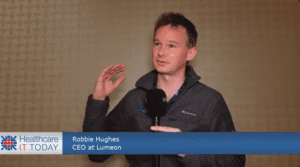Solidifying Home Care in the Healthcare Continuum: Embracing Technological Advances and RPM to Redefine Healthcare in 2024
 The following is a guest article by Jiang Li, CEO at Vivalink
The following is a guest article by Jiang Li, CEO at Vivalink
Healthcare is at a turning point, reshaping our view of what defines hospital care. The home has emerged as a fundamental care setting within the broader healthcare continuum, challenging the notion that care concludes at the hospital exit. To fully integrate the home into the continuum of care, our focus must be on innovative care models enabled by technology.
Recognizing the importance of the home in a patient’s care journey is essential. The aim is to create a seamless connection between hospital and home care, providing patients and their families with continuous support. Integrating home care into the overall healthcare plan guarantees a smooth transition, delivering support and personalized attention to patients.
Advances in healthcare technology provide the tools needed to facilitate and reshape hospital-level care in the home. Technologies such as remote patient monitoring (RPM) enable providers to extend their reach beyond traditional settings. Utilizing real-time data, continuous monitoring, and interactive communication, these advancements improve personalization, efficiency, and responsiveness to each patient’s unique needs.
From Chronic Care Management to Integrated Home Healthcare
The early phase of RPM predominantly centered around the management of chronic conditions like diabetes and hypertension. However, with a new generation of technology vendors, such as Vivalink offering real-time continuous monitoring, RPM has shifted to high-acuity care. Utilizing real-time sensors for continuous monitoring has opened the door to addressing more serious and immediate conditions.
RPM is entering its next phase, merging telehealth, chronic, and acute patient monitoring into a comprehensive digital healthcare platform. An integrated RPM platform is vital for extending care into the home. As patients transition from hospitals to their homes, continuity of care is maintained through remote monitoring. Real-time data obtained through RPM enables healthcare providers to deliver timely interventions, personalized care plans, and proactive management strategies.
Such a platform also optimizes the use of healthcare resources. Providers can allocate resources more efficiently by remotely monitoring patients and integrating different aspects of care. This, in turn, enhances the overall quality of care and ensures that resources are directed where they are most needed, contributing to a more sustainable healthcare system.
Human-Centric Strategies for Enhanced Adherence
To further solidify the home as a fundamental center for care, a thoughtful approach to enhancing patient adherence is essential. Adherence involves seamlessly incorporating healthcare practices into individuals’ lives, considering their habits and preferences. Diverse user groups, especially the elderly and those with health challenges, may face unique adherence hurdles.
Improving adherence can be achieved by focusing on user-centric design principles and ensuring technology solutions cater to a diverse audience, including older individuals, people with disabilities, and those with chronic conditions. Prioritizing simplicity and ease of use in product development ensures accessibility and user-friendliness, which are crucial for advancing chronic condition management.
While advanced features are valuable, healthcare technology’s success ultimately depends on its resonance with users. Even seemingly simple elements, such as font size on screens, can significantly impact adherence. Design technology with empathy and a deep understanding of human behavior. Simplifying the setup process by provisioning a turnkey solution can minimize technical challenges, ensuring users can easily activate their devices.
Enhancing Home Care in Specific Therapeutic Areas with RPM
Certain therapeutic areas are poised to benefit significantly from the transition to home-based care. RPM, for example, is particularly well-suited for enhancing cardiac monitoring. Cardiovascular issues, such as heart disease, remain among the leading causes of death worldwide. By providing continuous insights, RPM allows for the early detection and timely intervention of diseases.
Advancements in chemotherapy and emerging treatments like CAR T-cell therapies have transformed cancer care. Post-treatment, patients may experience side effects, such as CRS or neutropenia that demand careful monitoring. RPM, equipped with wearables and remote monitoring capabilities, is a valuable tool for post-treatment surveillance. As a result, providers can monitor patients’ well-being, detect potential side effects early, and intervene promptly. Extending cancer care into the home through RPM enhances patient comfort and reduces the necessity for frequent hospital visits, subsequently lowering infection risks.
Accelerating the Adoption of Hospital at Home (HaH) Models
The adoption of Hospital at Home (HaH), which enables patients to receive acute-level care in their homes, gained significant momentum during the pandemic, fueled by initiatives like CMS’ Acute Hospital Care at Home (AHCaH) waiver. Subsequently, the move toward an integrated RPM platform, particularly for acute care, is set to play a key role in the further global adoption of HaH solutions.
Recent research from Mass General Brigham delved into AHCaH outcomes for a diverse patient group. The study provides preliminary evidence that home hospitals are a vital care model for managing acute illness, particularly among socially vulnerable and medically complex patients. The findings revealed lower mortality rates and reduced necessity for escalated inpatient care among patients receiving care at home compared to those in a traditional hospital setting.
As telehealth, chronic care, and acute care come together, the increasing adoption of HaH solutions is set to enhance the continuum of care. The transformation doesn’t imply a shift away from traditional inpatient care. Instead, it marks a transition toward home-based options that utilize RPM and other advanced technologies. As a result, the home is more than just a place to live — it becomes a fundamental setting where comprehensive and advanced healthcare can be delivered.
Get Fresh Healthcare & IT Stories Delivered Daily
Join thousands of your healthcare & HealthIT peers who subscribe to our daily newsletter.




